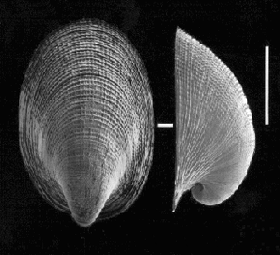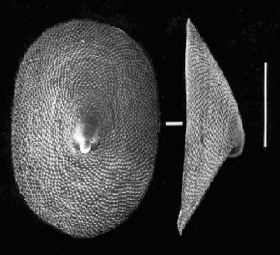How Deep is Deep? Museum Hunting for the Deepest Atlantic Mollusks
by José H. Leal, Ph.D.
Questions often arise concerning the distinction between "shallow-water" and "deep-water" shells. Where should we draw the line between deep and shallow water? Although we use these expressions very often in shell collecting and other natural history contexts, there is not a well-established, all-purpose boundary separating "shallow" from "deep." The terms are usually used in comparative situations. For instance, for someone who collects shells on the beach or at low tide, deep-sea species may be those that are not easily collected on the shoreline or on exposed sand flats. For them, deep-water species may be rarer species that require more sophisticated collecting methods, including snorkeling, SCUBA, or dredging.
Although there is not a rigid rule validating this, scientists may use "shallow-water" to indicate species living on the continental shelf bottom. The shelf is the area of ocean bottom that is just a continuation of the continental mass, usually extending to depths between 150 and 300 meters (or 500 and 1,000 feet.) Marine biologists like to use the term "sublittoral species" for organisms that live on the continental shelf; true "deep-water species" would appear only below that depth limit. "Deep-water" bottoms can be further subdivided into the archibenthal or bathyal zone (between 300 and 3,000 meters, or 1,000 and 10,000 feet), the abyssal zone (between 3,000 and 6,000 meters, or 10,000 and 20,000 feet), and the hadal or ultra-abyssal zone (below 6,000 meters, or 20,000 feet). The latter category includes only areas of submarine trenches, where the ultimate deep-water species are found! The deepest point of all oceans, about 11,000 meters (36,000 feet), is located in the Marianas Trench, western Pacific Ocean.
Upon my return to South Florida in 1994 following a two-year postdoctoral appointment at the Smithsonian Institution's Division of Mollusks, I went to work at the University of Miami's Rosenstiel School of Marine and Atmospheric Science (RSMAS). In my search for "deep-water" (bathyal and abyssal) mollusks on the shelves of the University's Marine Invertebrate Museum, I ran into several big five-gallon jars, all filled to the rim with pieces of wood, seagrass blades, seeds of land plants and, curiously enough, coarse chunks of rusty metal that looked like the solidified remains of molten lava. All of that was immersed in alcohol and, after almost 30 years of maceration, the concoction had turned into a solution the color of dark tea.
As I started to empty the contents of the big jars onto sorting trays, the key to the mystery appeared in the form of little tags with capital letters and numbers. The University of Miami station "numbers" are always preceded by one or two initials. The letters stand for the names of their now legendary research vessels; the numbers represent stations. Their well-kept station records disclosed all the information I needed: location, including latitude and longitude, dates, depths, personnel working on board, kind of gear used (mostly big deep-sea trawls), all indicating exactly in what part of the world's oceans the samples were obtained. The pickled plant material came from the floors of the Cayman and Puerto Rico trenches, in the Caribbean region! As I carefully sorted through the alcohol-preserved plant material under the microscope, I finally found what I was so eagerly looking for: small, white, yellowish, or brown limpets, with a maximum size of about a quarter-of-inch in length. And what a surprise! According to the station records of R/V Gilliss, the material from station GS-109 in the Puerto Rico Trench, a trawl haul obtained at 8595 meters (28,000 feet) and yielding many limpet specimens, came from near the deepest spot in the Atlantic Ocean! Although shallower than the Marianas Trench, the Puerto Rico Trench is as impressively deep as Mount Everest is high.

The Cayman and Puerto Rico trenches basically represent tectonic plate boundaries, or areas of the ocean floor where the gigantic individual plates that cover the Earth's surface are in contact, colliding or sliding past each other. As a result, earthquakes and volcanic activity abound at and near trench areas. Submarine volcanic activity produces the rusty, metallic nodules I found inside the jars. These are usually blends of iron, manganese, and other minerals.
Trenches are frequently close to tropical islands, and there is steady accumulation of plant debris falling from these nearby land, mangrove, and seagrass environments onto the trench floors. It is by a fortuitous combination of circumstances that herbivorous hadal limpets like the ones I had found are furnished with a permanent supply of plant food. Mollusks living in the less-populated, shallower abyssal zone (between 3500 and 6000 meters, or 11,500 and 20,000 feet), must depend upon the "rain" of occasional fish carcasses and other animal debris falling from the upper layers of the water column (in the case of scavenger species), or upon random encounters with prey (in the case of predators). So it seems somehow ironic that mollusks living in the very deepest parts of the oceans must rely on food coming directly from land or from very shallow water areas! That situation represents a kind of "short circuit" in the classic ecological model for deep-sea food webs. Most descriptions of deep-sea food-webs involve a large number of feeding levels based on the large physical distance separating primary producers (plants, which are absent in the dark deep-sea) from predators and scavengers, and the absence of herbivore groups such as keyhole and true limpets.
After a couple of years of studies, and with the help of my colleague, M.G. Harasewych, curator of mollusks at the Smithsonian Institution in Washington, D.C., and, like myself, also deeply (!) involved with this type of mollusk, I prepared a manuscript summarizing the results of our research. The work we did was funded in part by a 1995 COA Research Grant Award I received. All limpets found at the RSMAS Museum can be grouped into four species belonging to two different families in the Order Cocculiniformia. The Cocculinidae are Fedikovella caymanensis Moskalev, 1976 and a new species also belonging to a new genus; the Pseudococculinidae are Caymanabyssia spina Moskalev, 1976, and Amphiplica new species.

Cocculinidae
Fedikovella caymanensisMoskalev, 1976
Cayman Trench
Scale line = 1mm

Cocculinidae
New Genus, new species
Inset shows internal apical septum.
Scale line = 1mm

Pseudococculinidae
Caymanabyssia spinaMoskalev, 1976
Cayman Trench
Scale line = 1mm

Pseudococculinidae
Amphiplica new species
Scale line = 1mm
The two named species were first found by Lev Moskalev, from the Russian Academy of Sciences, after extensive field work carried out in the early 1970s by Russian research vessels in the Caribbean Sea. All four species are fully adapted to their ultra-deep-water lifestyles. They lack eyes, for there is no light available for vision; instead, they rely on smell and touch, having batteries of cilia, or miniature tentacles, near or around their mouths. They are equipped with sturdy radulae capable of scraping the hard wood or other plant material. Their shells are covered by very thick periostracums that help protect the calcium carbonate underneath from the chemical attack of acids present in the surrounding water. The organic protein content in their shells is also higher than in other gastropods, a resource that further enhances protection against shell dissolution by acids. Cocculiniform limpets are hermaphroditic, each animal having both female and male reproductive systems. Finding a mate can be difficult in deep-water conditions, and hermaphroditism ensures that when one mating event occurs, two animals are fertilized through mutual cross fertilization, thus increasing the chances for perpetuation of the species.
The ultra-deep-sea limpets certainly compelled me to reevaluate my notions about deep-water mollusks and to stimulate me to research one of the last frontiers of the world's ocean.
Director, The Bailey-Matthews Shell Museum, P.O. Box 1580, Sanibel Island, FL 33957
See also Dr. Leal's article, "Deep-Sea Mollusks -- An Introduction".


